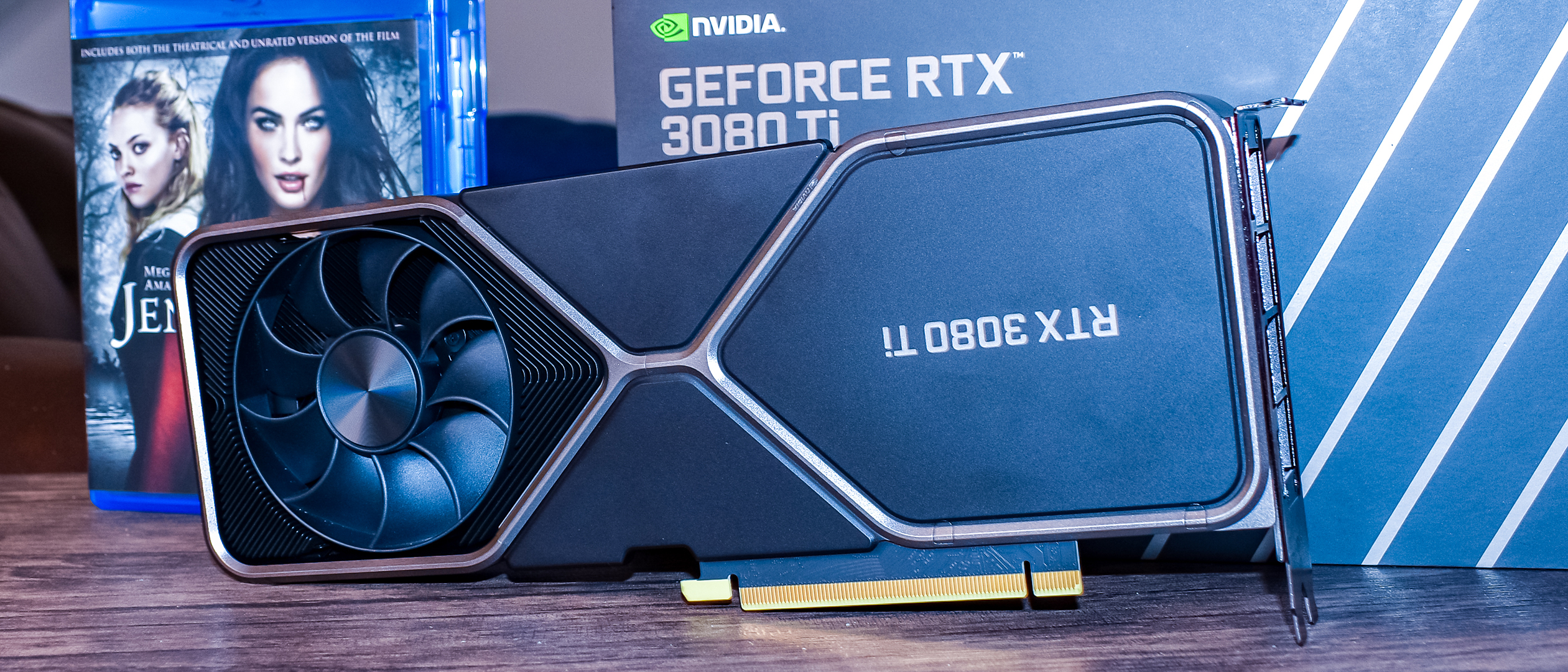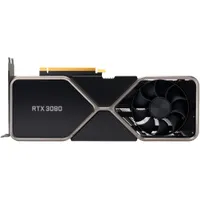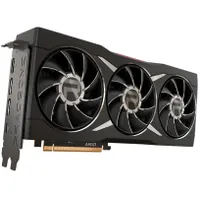TechRadar Verdict
The Nvidia GeForce RTX 3080 Ti is an absolute monster of a graphics card, delivering RTX 3090-level gaming performance at a lower price. However, the high starting price may still be a turn off for budget-conscious folks that just want to get some PC gaming in.
Pros
- +
Excellent performance
- +
Beautiful graphics card
- +
Same size as RTX 3080
- +
Good thermal performance
Cons
- -
Very expensive
- -
Power-hungry
Why you can trust TechRadar
Nvidia GeForce RTX 3080 Ti: Thirty second review
Any other year and the Nvidia GeForce RTX 3080 Ti would be a welcome sight.
Nine months separate the launch of the 3080 Ti and our Nvidia GeForce RTX 3080 review, and though that’s the usual time frame for a refresh, it’s a strange time to stick to that schedule.
While Nvidia surely has justifications for going ahead with this mid-generation refresh, the world of GPUs along with almost everything else tech-related, has been turned upside down.
Right now, consumers have been struggling to get hold of the best graphics cards, no matter if they’re from AMD vs Nvidia. The global chip shortage has made supply extremely limited and hard to come by, and so anyone in the market for a new GPU has to either contend with scalpers charging double the price or store lotteries for the small chance of getting one.
These conditions are not ideal for the release of a new GPU, especially one that costs $1,199. If, by chance, you’re able to get your hands on a RTX 3080 TI, you won’t be disappointed. It is a powerhouse, taking the RTX 3090 and halving the VRAM for a more consumer-oriented card.
Even in more normal times, though, it’s not the easiest graphics card to recommend, since it’s not that much more powerful compared to the RTX 3080, but it is much more expensive.
Nvidia GeForce RTX 3080 Ti: Price and availability

- Much more expensive than the RTX 3080, but not that much more powerful
- A great value alternative to the RTX 3090
The Nvidia GeForce RTX 3080 Ti is available June 3, starting at $1,199 / £1,049 / AU$1,949. Prices for the RTX 3080 Ti will probably vary wildly from that minimum price, and third-party versions of the GPU will probably sell for much higher.
Sign up for breaking news, reviews, opinion, top tech deals, and more.
Given that the RTX 3080 launched in September 2020 for just $699 (£649, about AU$950), you’re paying nearly twice as much for the RTX 3080 Ti. Given that this GPU has just 2GB more VRAM and 17% more CUDA cores, that 71% price mark-up might be hard to swallow right now.
Although, this graphics card does deliver pretty much the same level of performance as the card in our Nvidia GeForce RTX 3090 review for about $300 less (at least going by MSRP), so it might be worth grabbing if you had your eyes on one of the best Nvidia GeForce graphics cards on the market but are put off by their premium price tags.
- Value: 3.5 / 5
Nvidia GeForce RTX 3080 Ti: Features and chipset
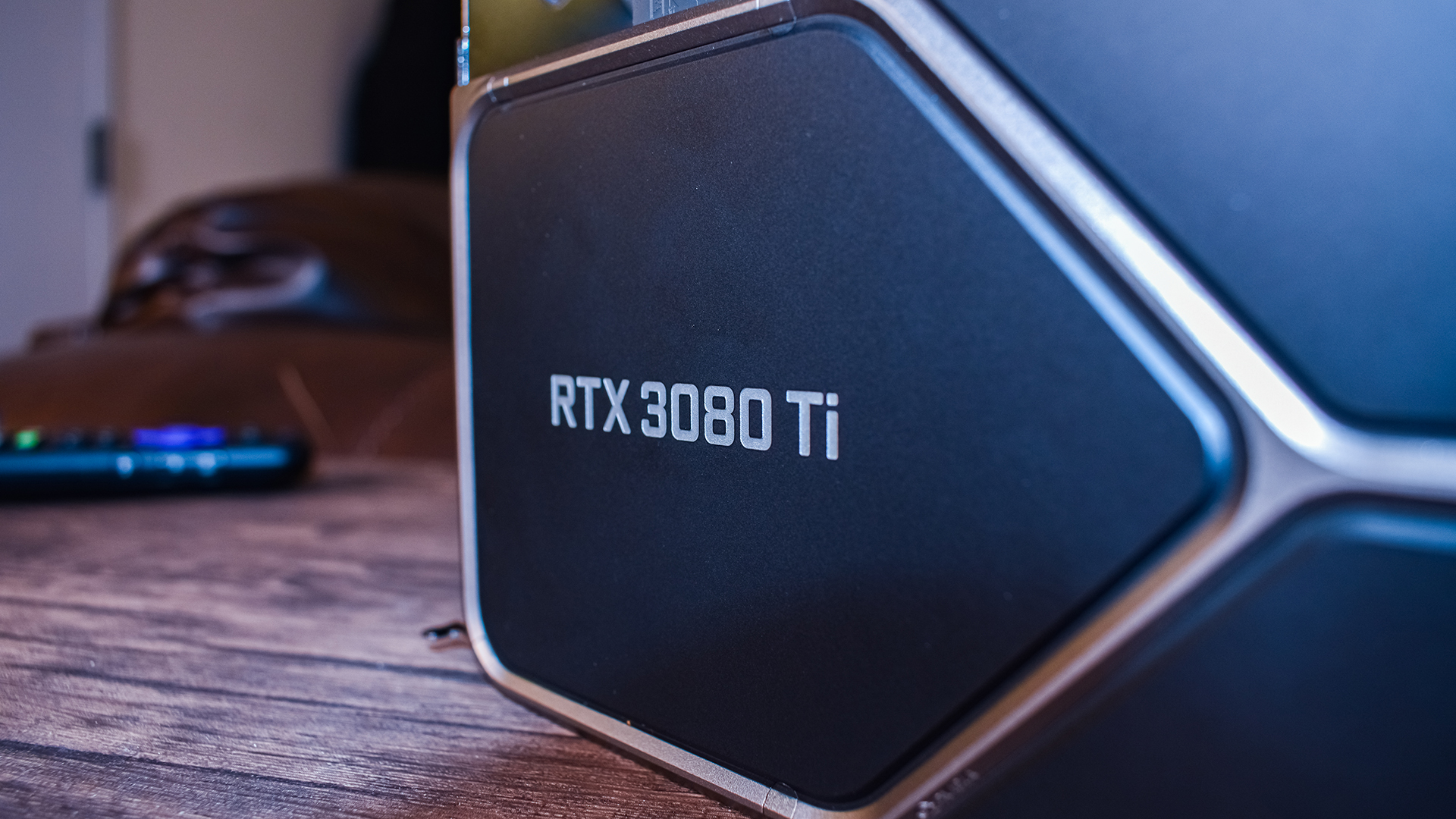
- A 17% increase in CUDA cores over RTX 3080
- Includes hardware-based hash rate limiter to thwart crypto mining
- An additional 2GB VRAM will help with 4K gaming performance
Just like the rest of the Nvidia GeForce RTX 3000 series, the RTX 3080 Ti is built on the Nvidia Ampere architecture, and brings with it the same improvements as the rest of the lineup. There is something new to the table, however.
GPU: GA102
Stream multiprocessors: 80 (128 CUDA per SM)
CUDA Cores: 10,240
Tensor cores: 320
Ray tracing cores: 80
Power Draw (TGP): 350W
Boost clock: 1,665MHz
VRAM: 12GB GDDR6X
Memory Speed: 19Gbps
Interface: PCIe 4.0 x16
Outputs: 1 x HDMI 2.1, 3 x DisplayPort 1.4
Power connector: 1 x 12-pin
As with the card in our Nvidia GeForce RTX 3060 review that launched in March 2021, the Nvidia GeForce RTX 3080 Ti has a hardware-based hash rate limiter that should limit the appeal to cryptocurrency miners. We don’t test mining performance at TechRadar, so we can’t speak to how effective this limit actually is. But given that the hash rate limiter on the RTX 3060 was accidentally bypassed by Nvidia’s own driver update, we’ll just have to wait and see how well this actually dissuades miners from buying this graphics card in bulk.
Beyond that, the Nvidia GeForce RTX 3080 Ti is actually quite a bit beefier than the original RTX 3080, and that largely falls to core count and memory bandwidth.
Because, sure, the Nvidia GeForce RTX 3080 Ti does have more VRAM, with 12GB of GDDR6X compared to 10GB of the stuff on the original card, but it’s also on a faster 384-bit memory bus. That means you get 912 GB/s of memory bandwidth on the RTX 3080 Ti compared to the RTX 3080’s 760 GB/s. With faster VRAM, not to mention just more memory, the RTX 3080 Ti should be even more adept at 4K gaming in the future.
The RTX 3080 Ti is straight up more powerful, as well. The GPU has 10,240 CUDA cores across 80 compute units, compared to the RTX 3080’s 8,704 CUDA cores. That’s a 17% increase in core count, but don’t expect a strict 17% performance increase - more on that later.
You’re also going to get access to Nvidia’s whole suite of software features, and it’s not just limited to gaming.
The one we are still in love with is Nvidia Broadcast, which is ostensibly designed for streamers and content creators, but we find that it is incredibly useful in just day-to-day life. We use it a lot when we’re taking meetings, or even just hanging out with friends in Discord, especially because it filters out most of the New York City street noises outside our street-facing apartment window.
Of course, you also get access to Deep Learning Super Sampling, or DLSS. This tech uses the Tensor cores – the RTX 3080 Ti has 320 of those – to upscale a lower resolution to your native resolution. The idea is that DLSS will let you turn on more of the shiny graphics options, so you don’t have to sacrifice image quality just to hit a decent framerate, especially at high resolutions like 4K.
- Features & chipset: 5 / 5
Nvidia GeForce RTX 3080 Ti: Design
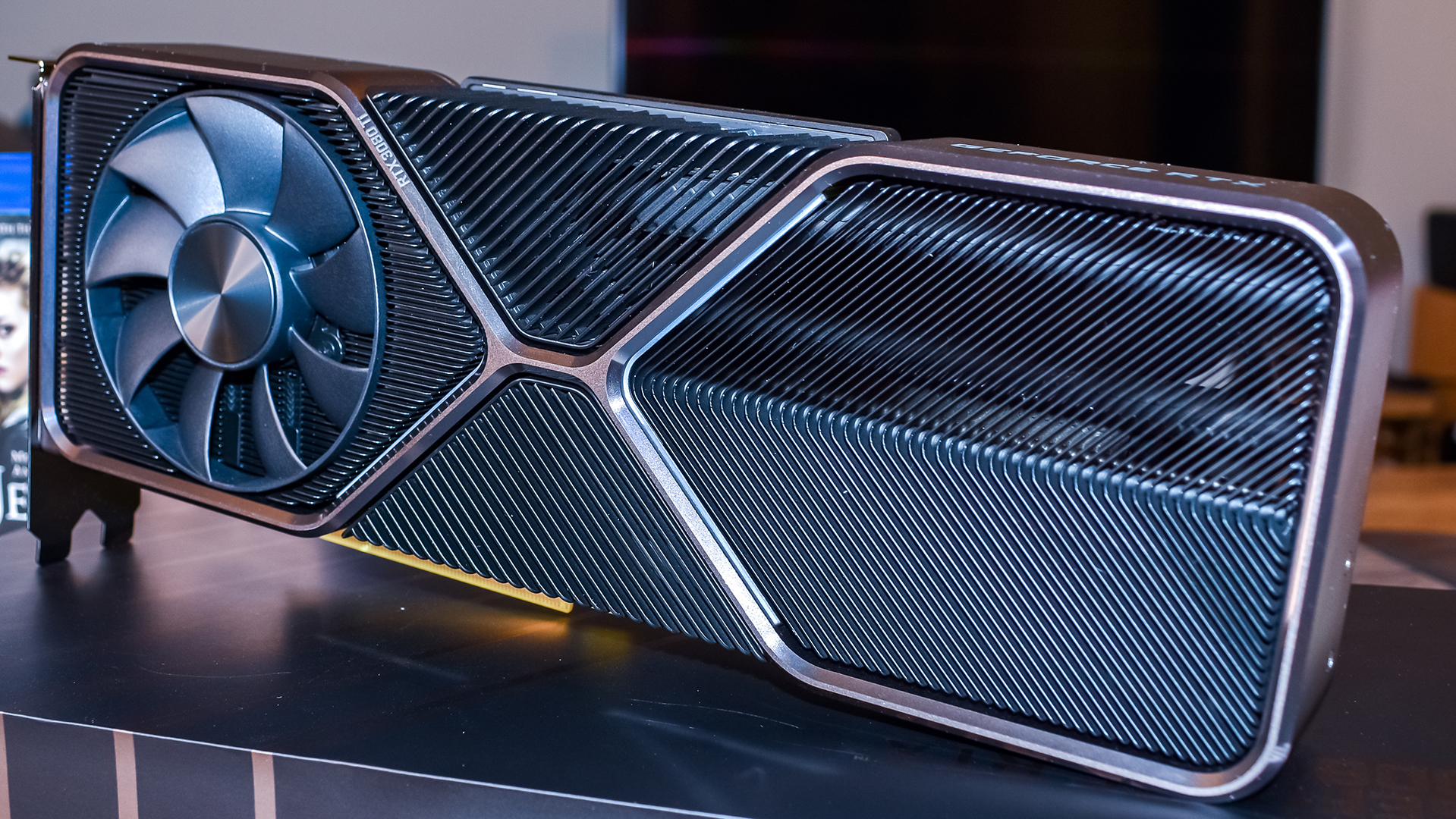
- Same size as the RTX 3080, so will fit in the same case easily
- Same design as other Founders Edition cards, so still looks great in a case
The Nvidia GeForce RTX 3080 Ti we reviewed is Nvidia’s Founders Edition, and, well, it looks like the rest of the RTX 30-series Founders Edition cards. The graphics card has an attractive black and gunmetal gray colorway. You’ll aso see Nvidia and RTX 3080 Ti branding etched into the metal. That’s not something you’ll notice once you actually have the graphics card in your PC, but it’s a nice touch.
The RTX 3080 Ti is the exact same size and weight as the original RTX 3080, which means it’s 4.4 inches thick and 11.2 inches long, so it should fit in most cases.
There are two fans on the RTX 3080 Ti and just like the RTX 3080 and RTX 3090, there’s one on the front and one on the back. This fan configuration pulls air through the front of the card, it’ll go through the card, and go out through a fan on the back of the card, probably shooting the hot air through the top of your case.
It’s an extremely effective method of cooling the RTX 3080 Ti, and even with a peak power consumption of 350W, the RTX 3080 Ti peaks at just 78.9C. That is a lot higher than the RTX 3090’s 72C peak temperature, even though that card has the same level of power consumption.
But it’s actually impressive that Nvidia was able to get that close in thermals, considering that it was able to shrink the cooler back down to a dual-slot design, rather than the giant triple-slot RTX 3090 Founders Edition.
Finally, Nvidia has of course included the 12-pin power connector. It does mean that you’re probably going to have to use an adapter to power the Nvidia GeForce RTX 3080 Ti, but of course, Nvidia has included an adapter in the box.
- Design: 4 / 5
Nvidia GeForce RTX 3080 Ti: Performance
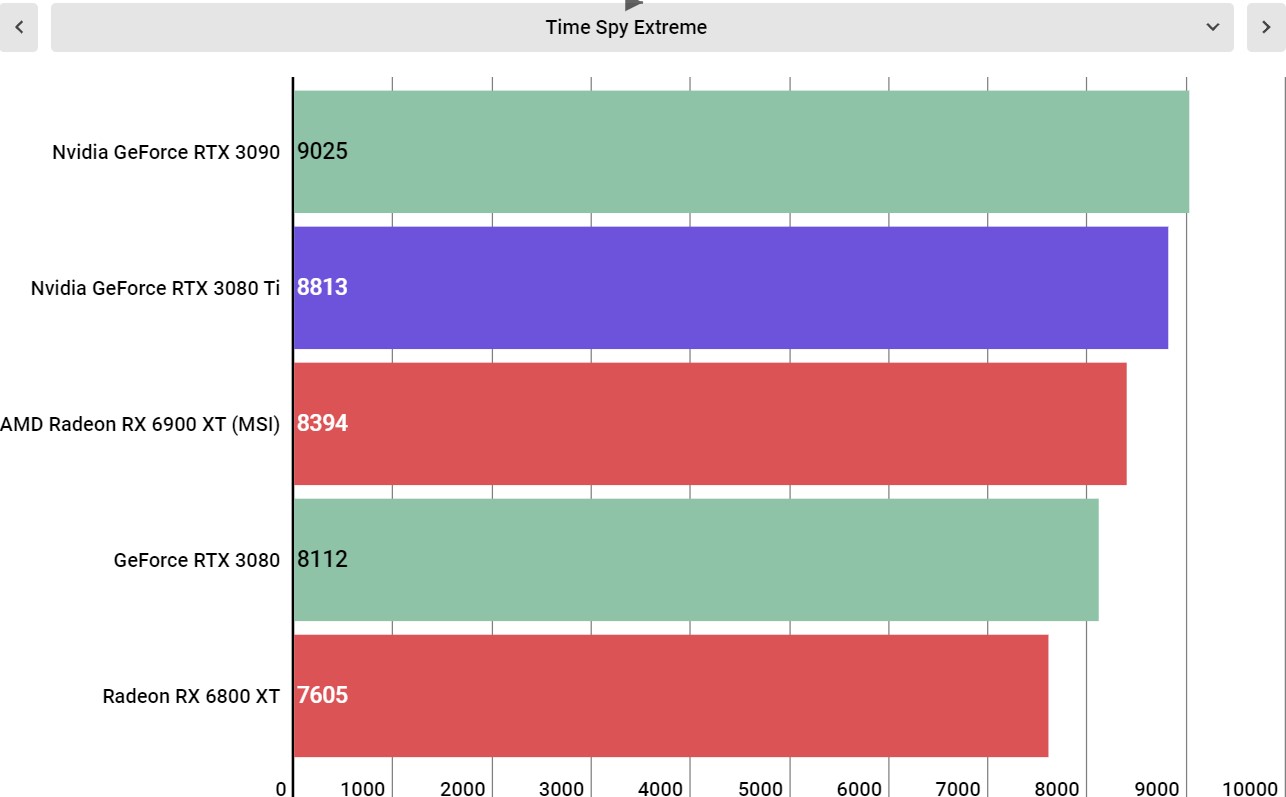
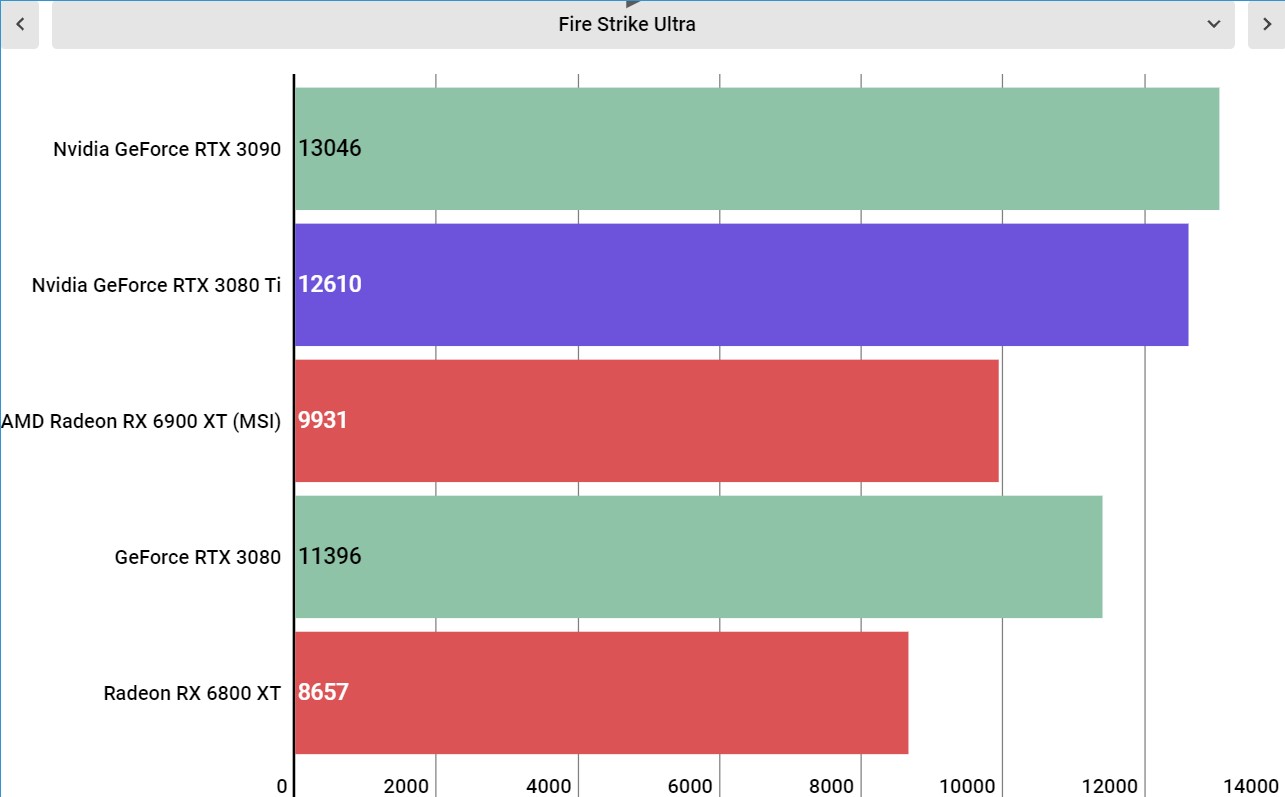
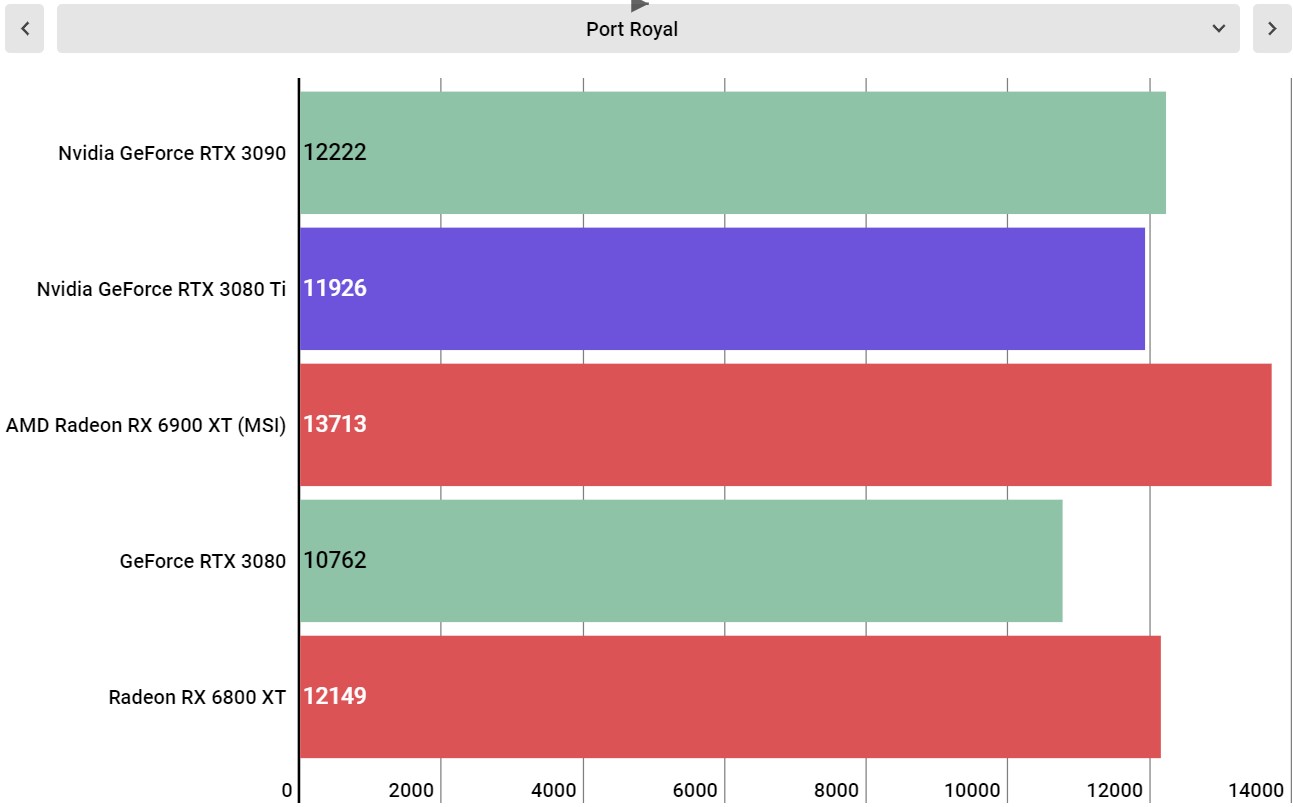

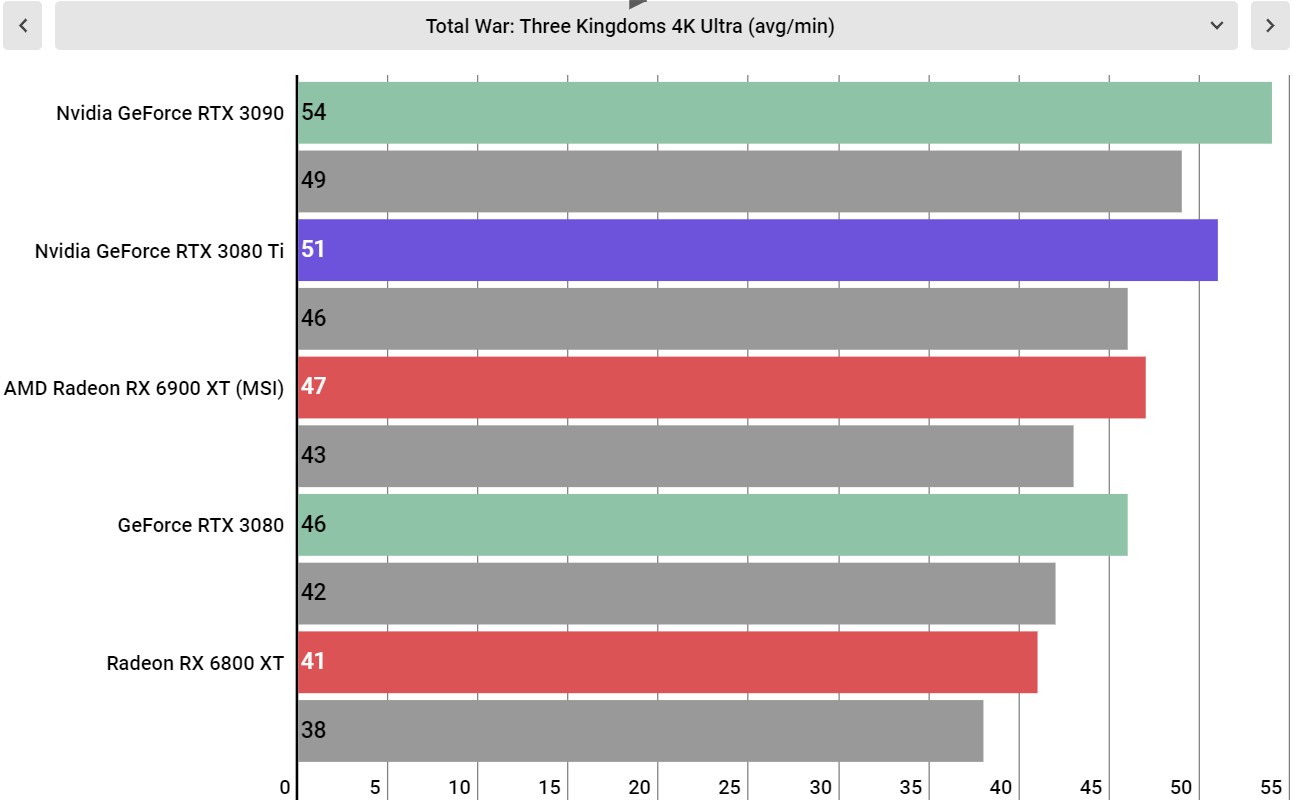
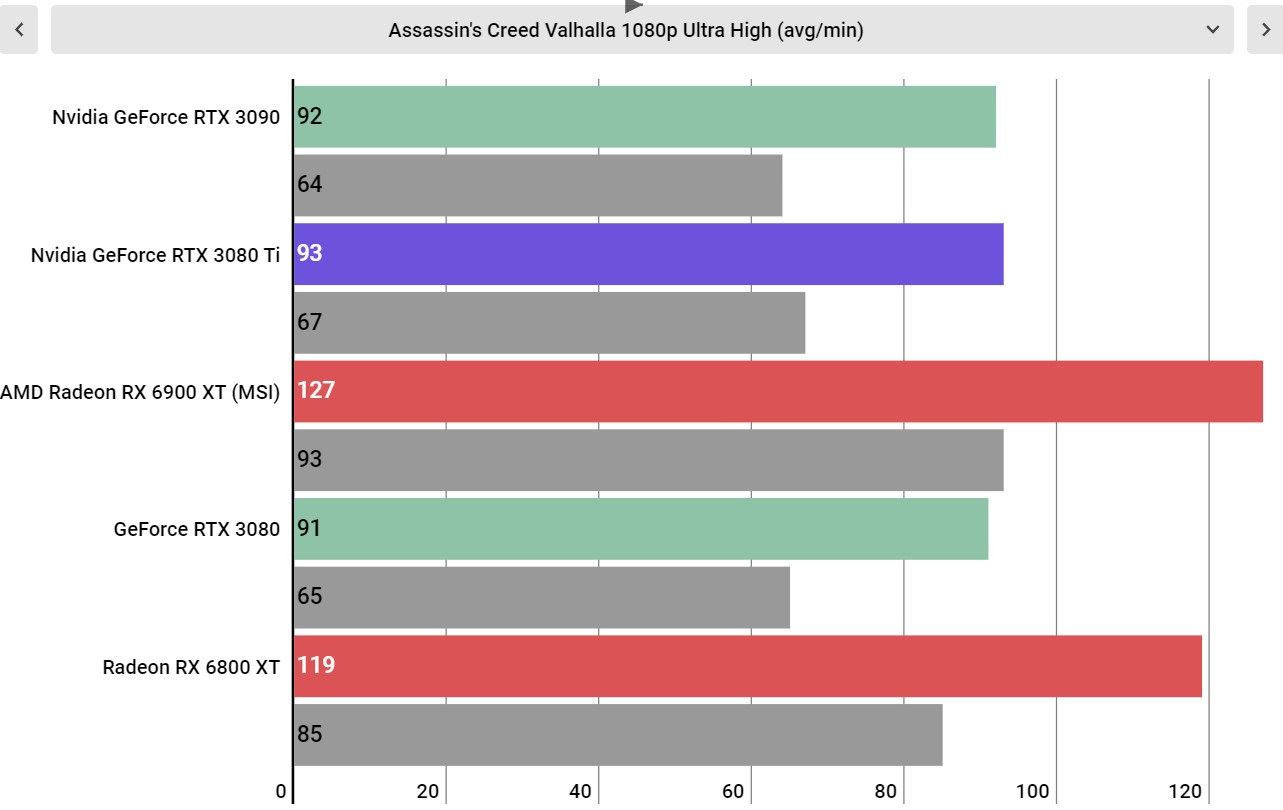
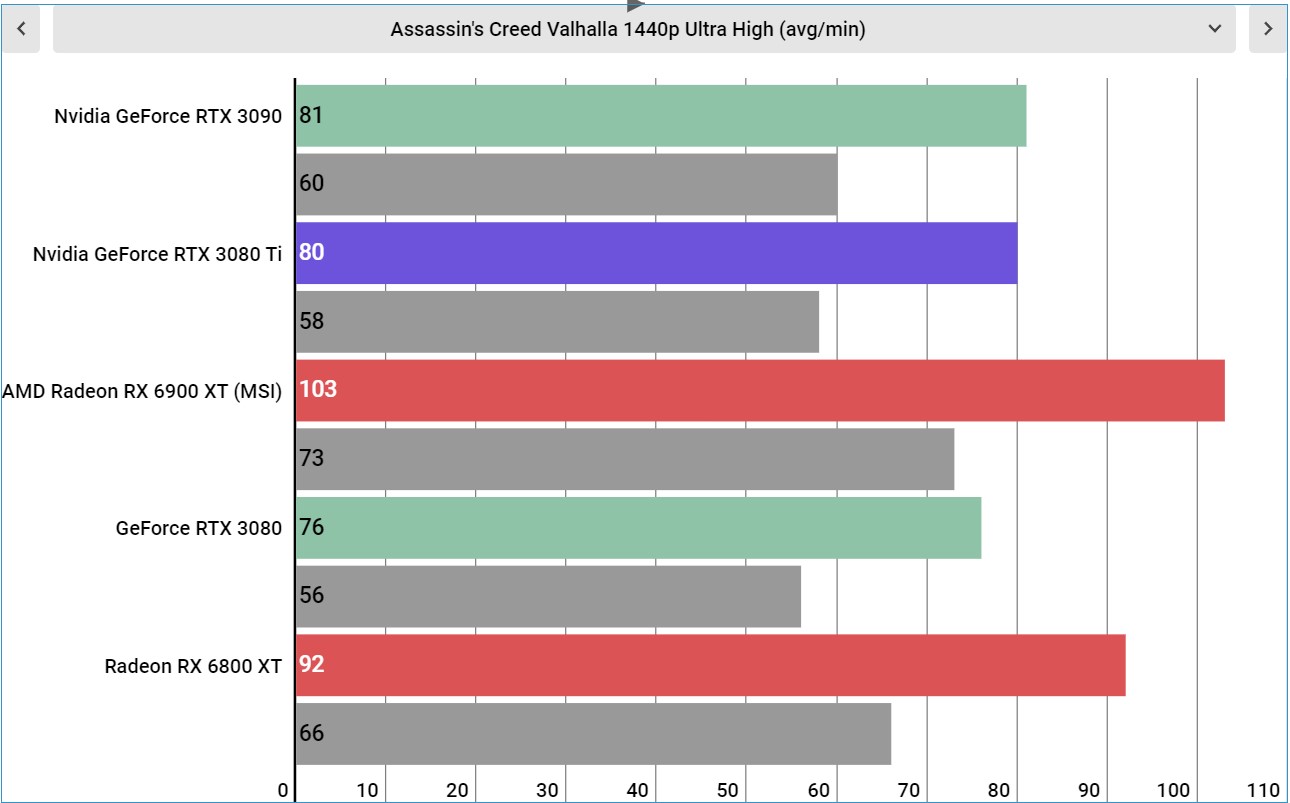
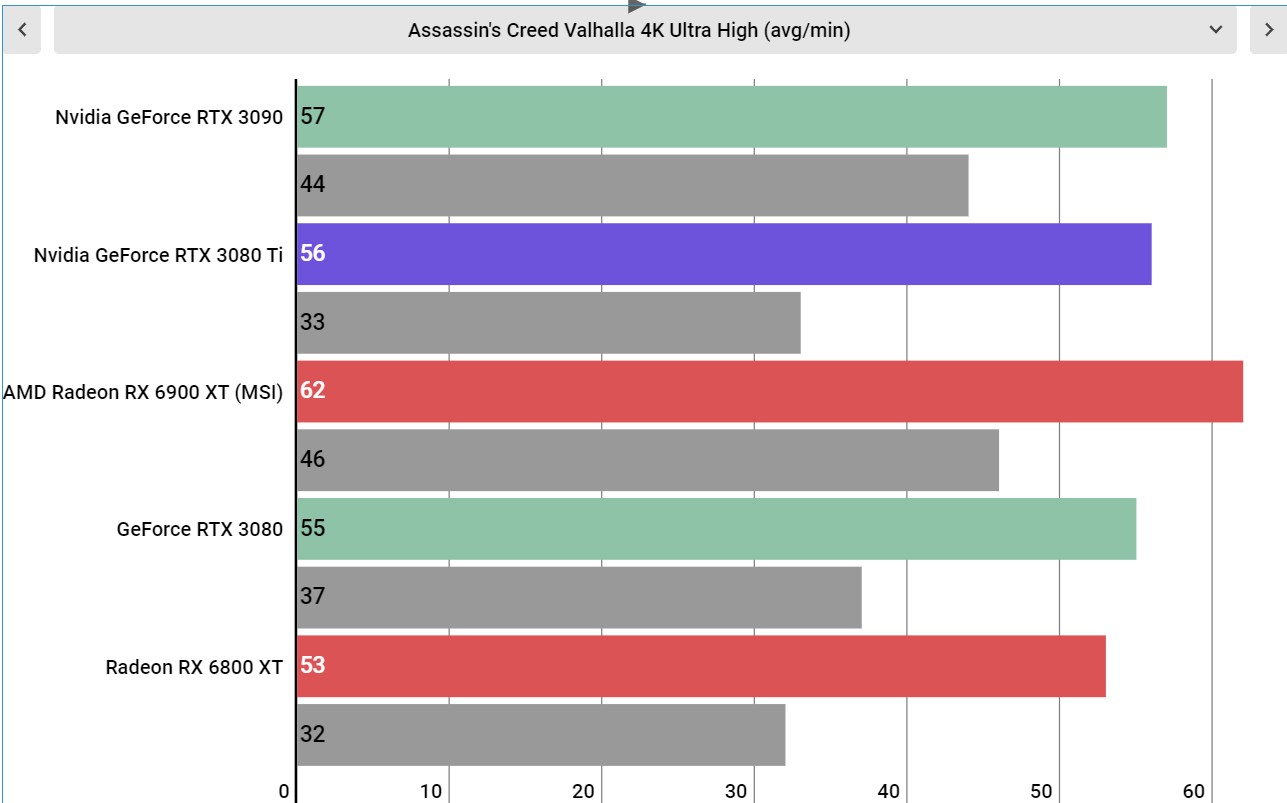
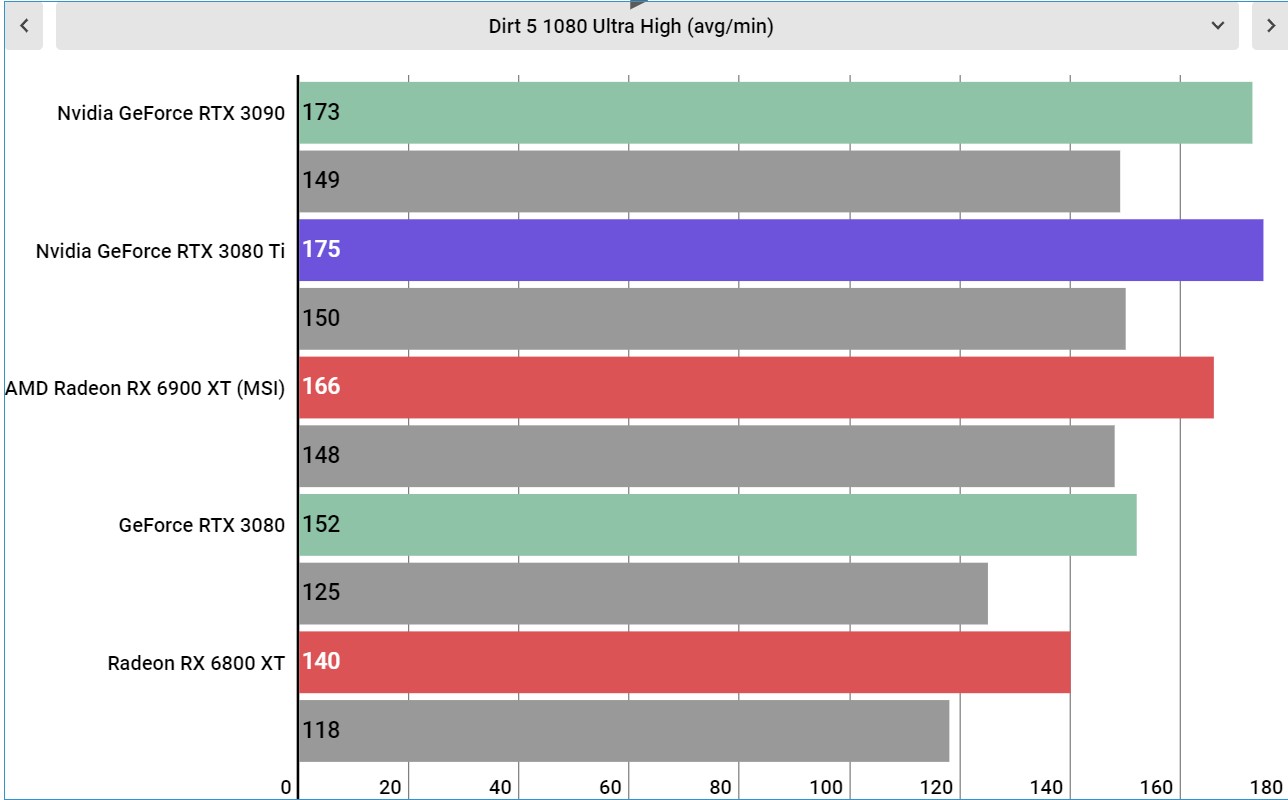
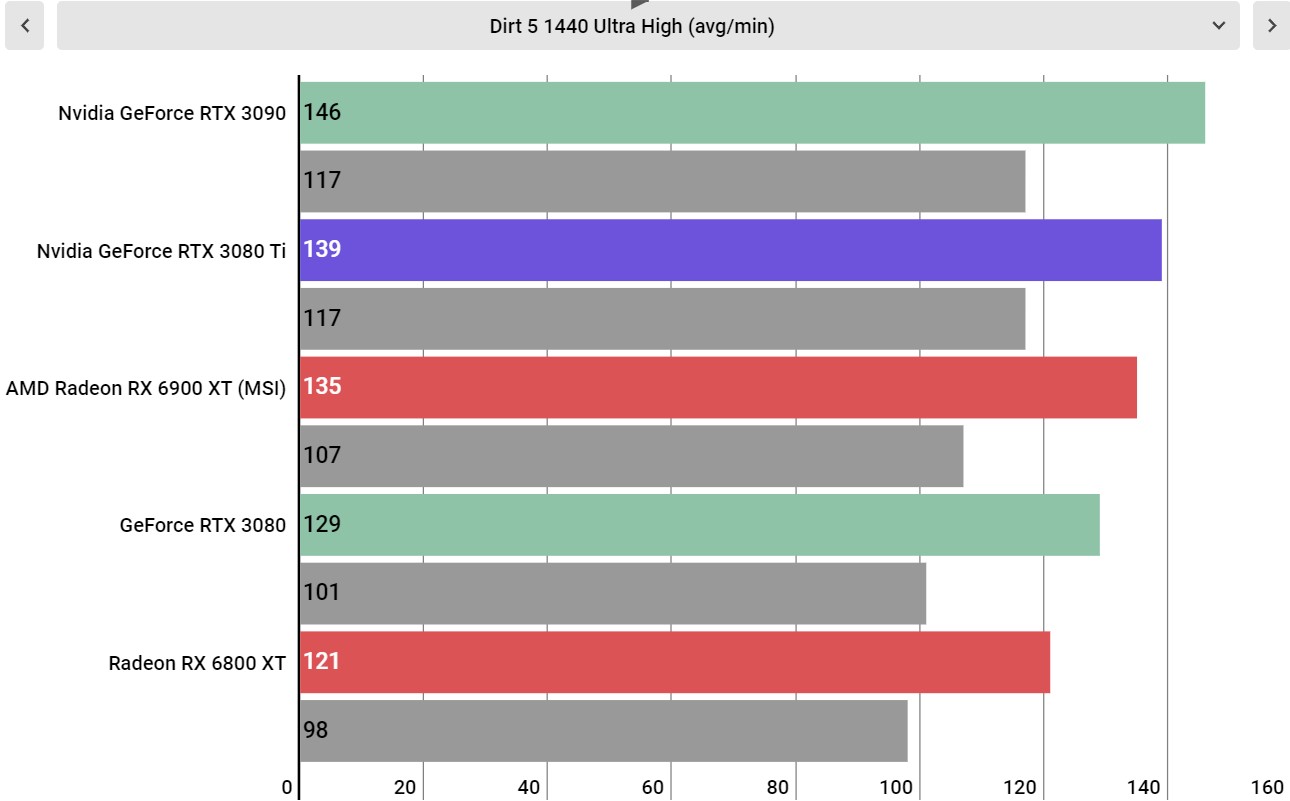
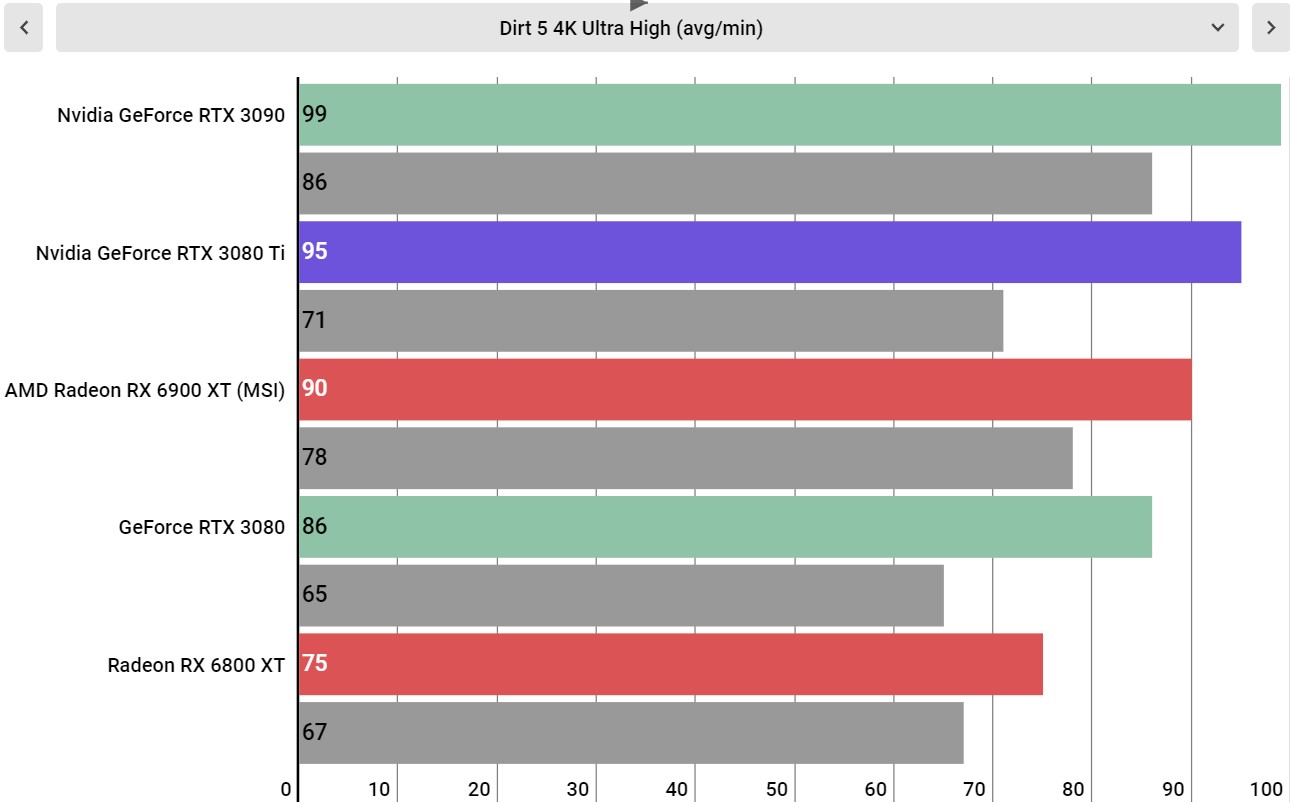
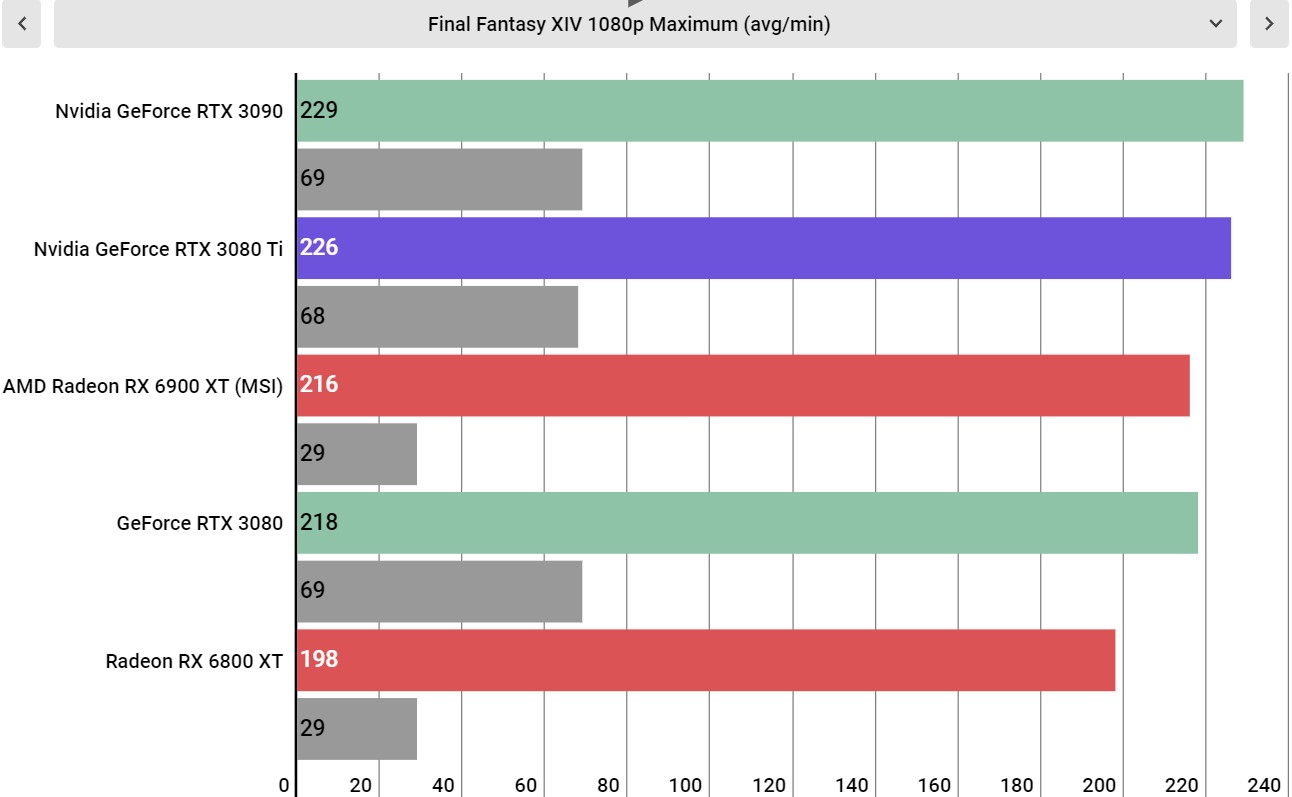
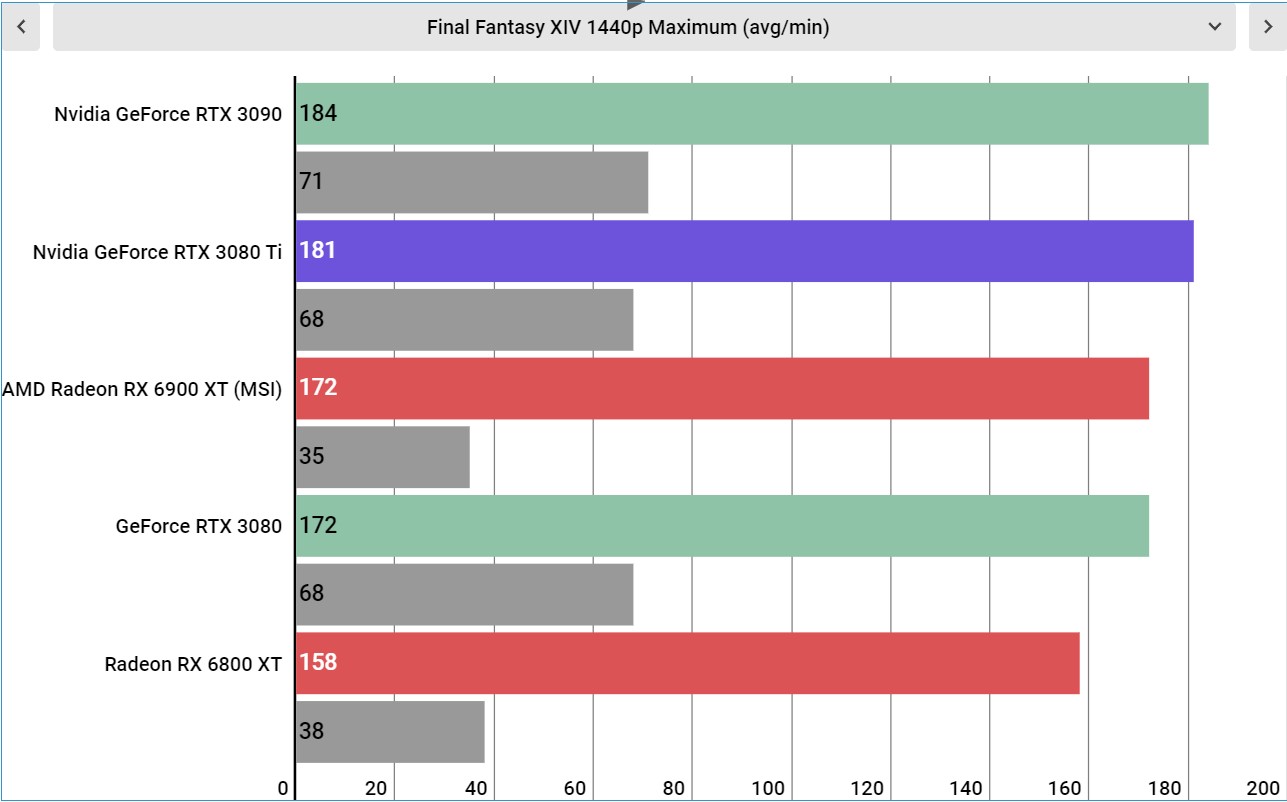
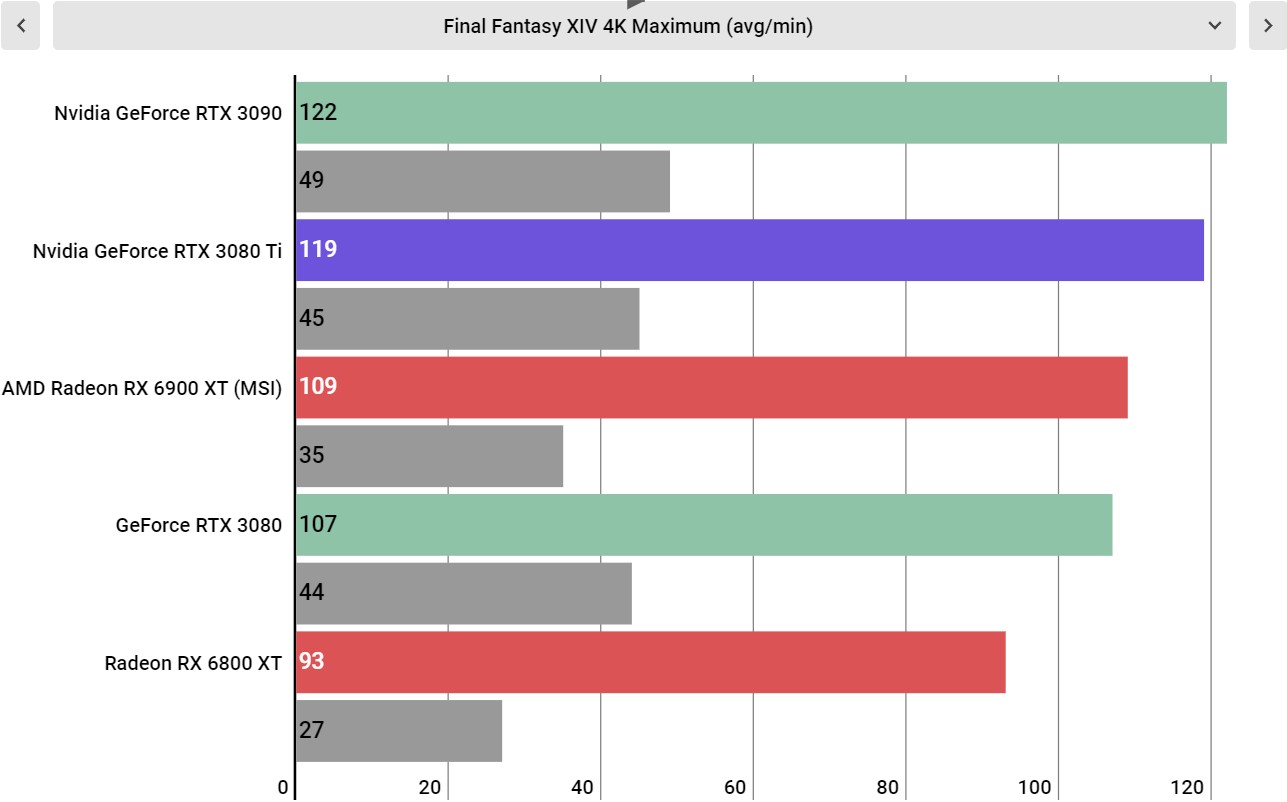
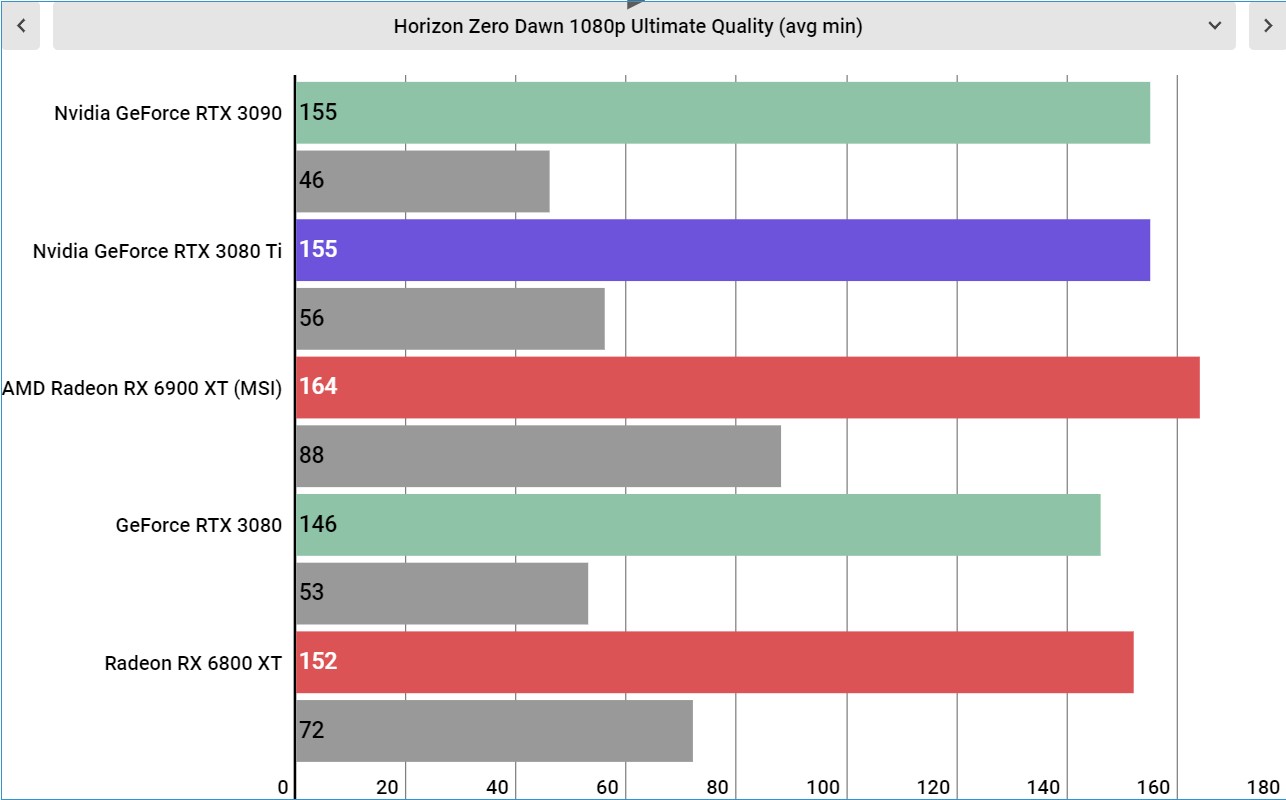
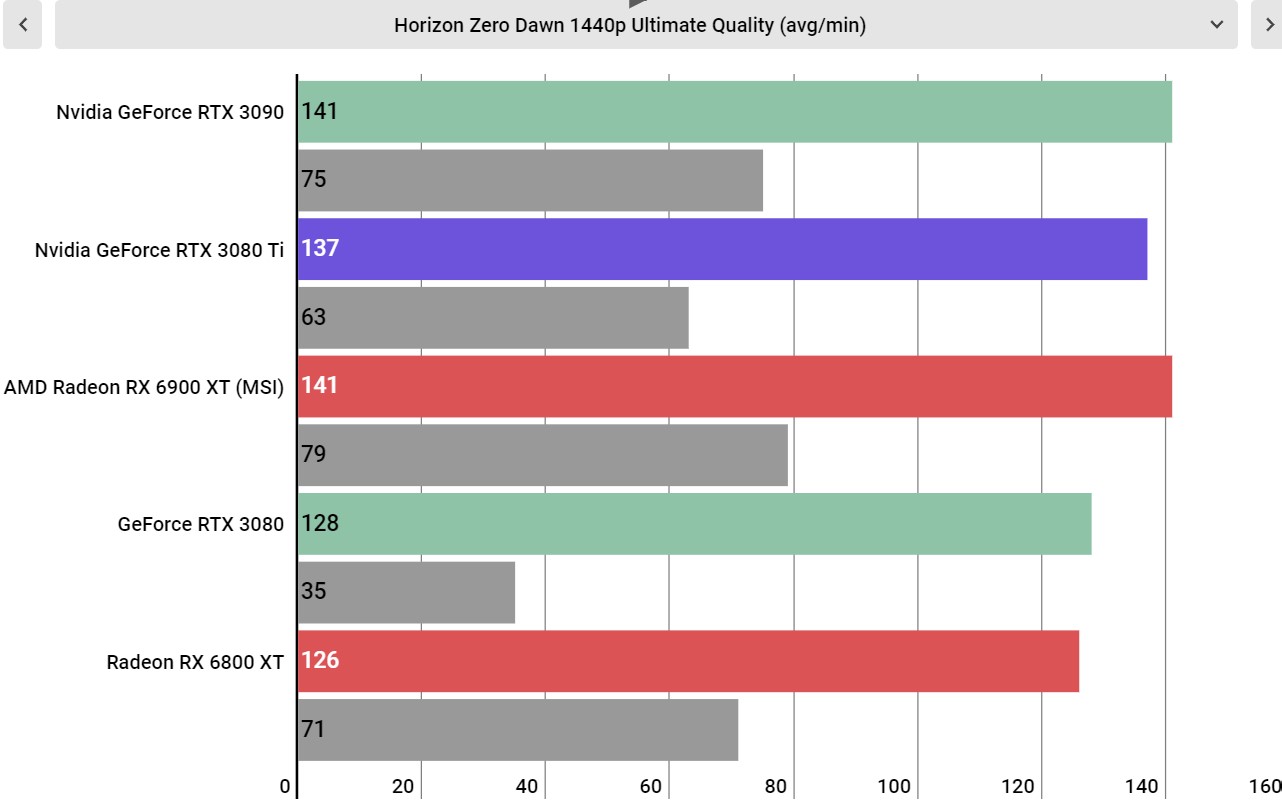
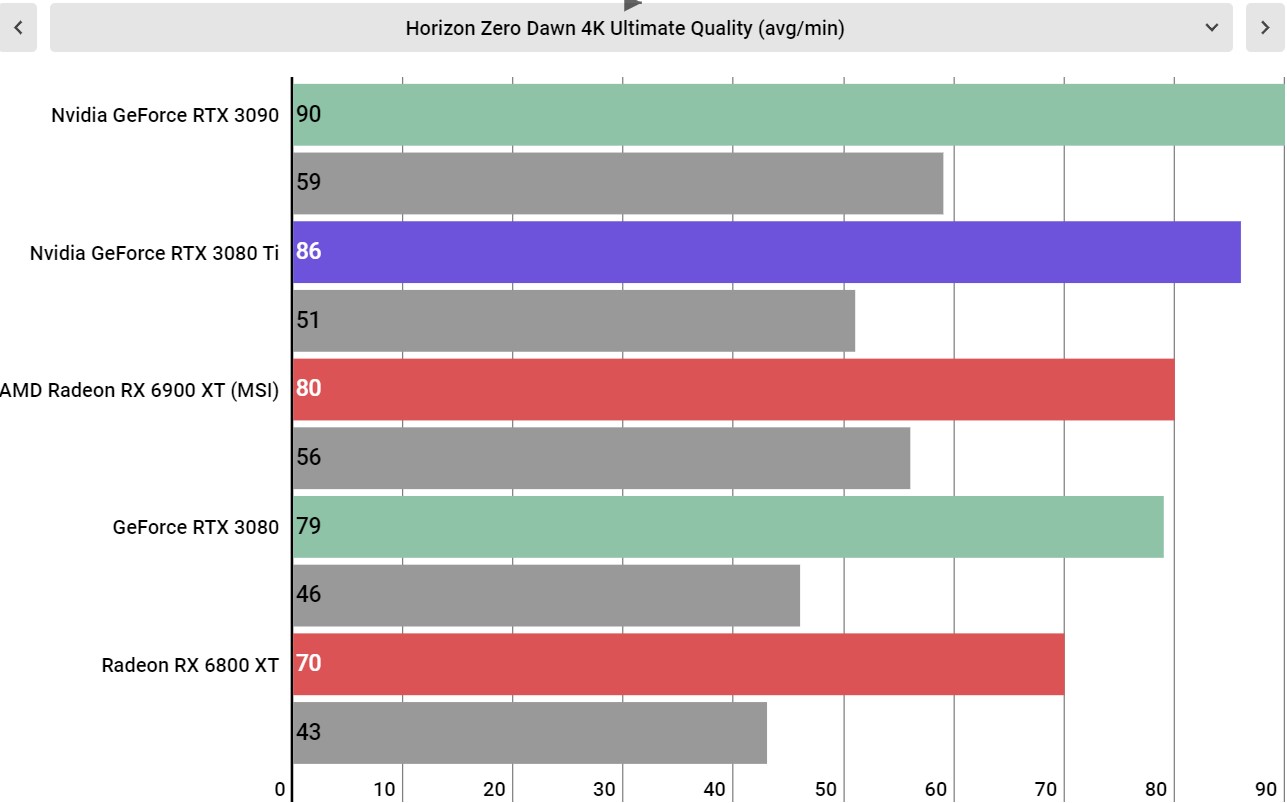


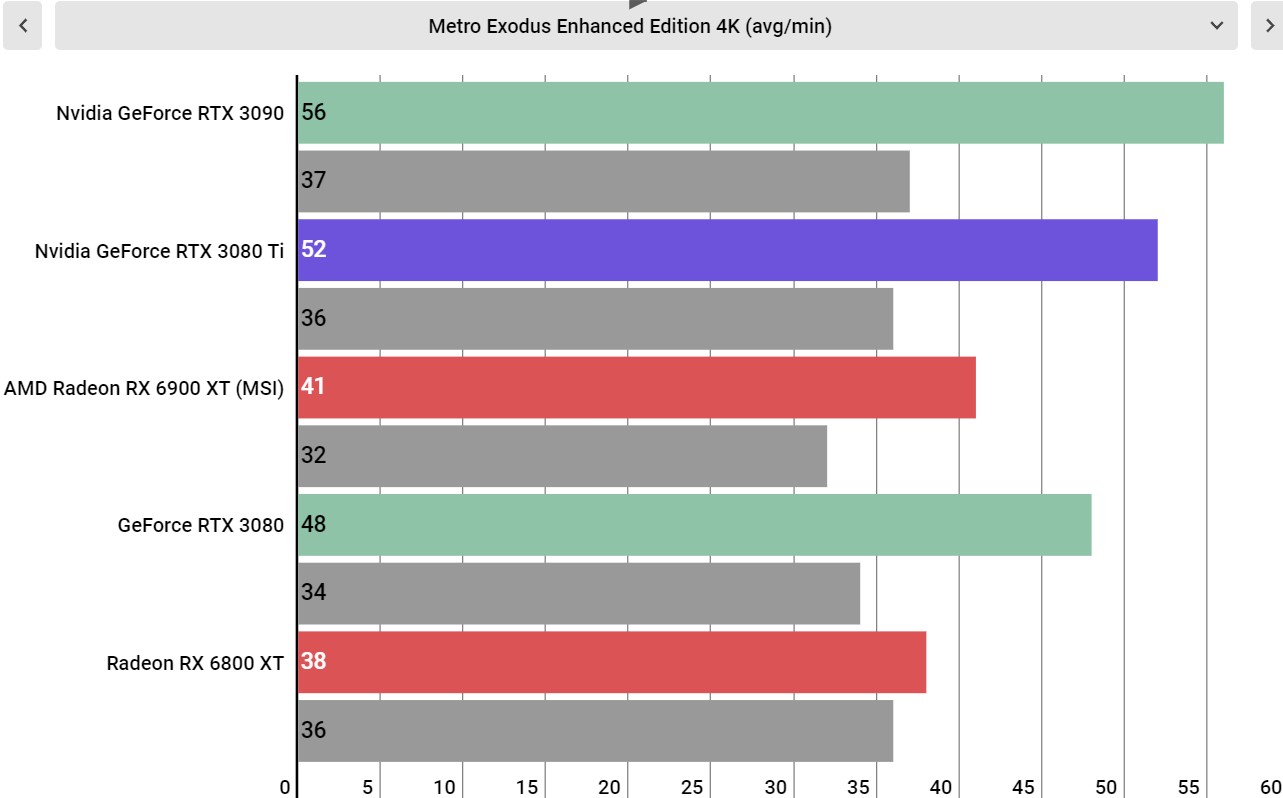

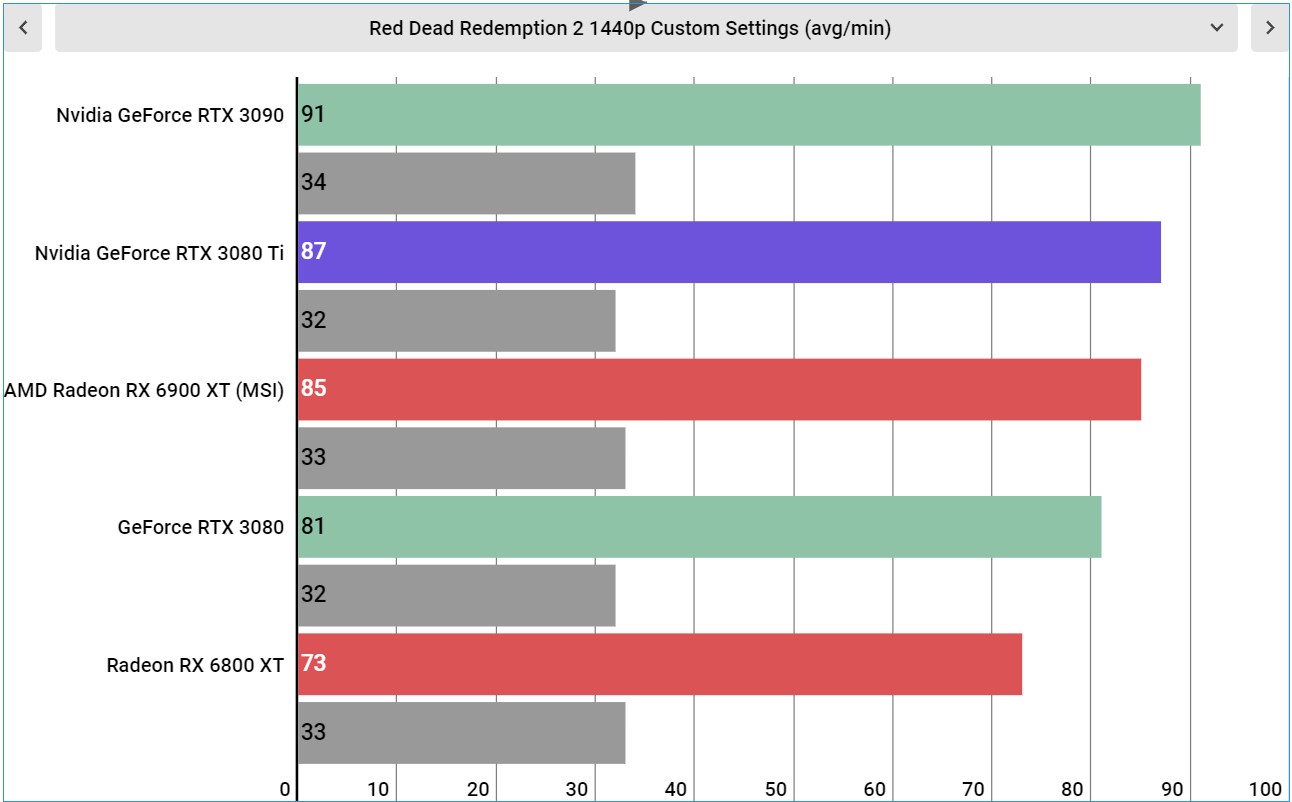
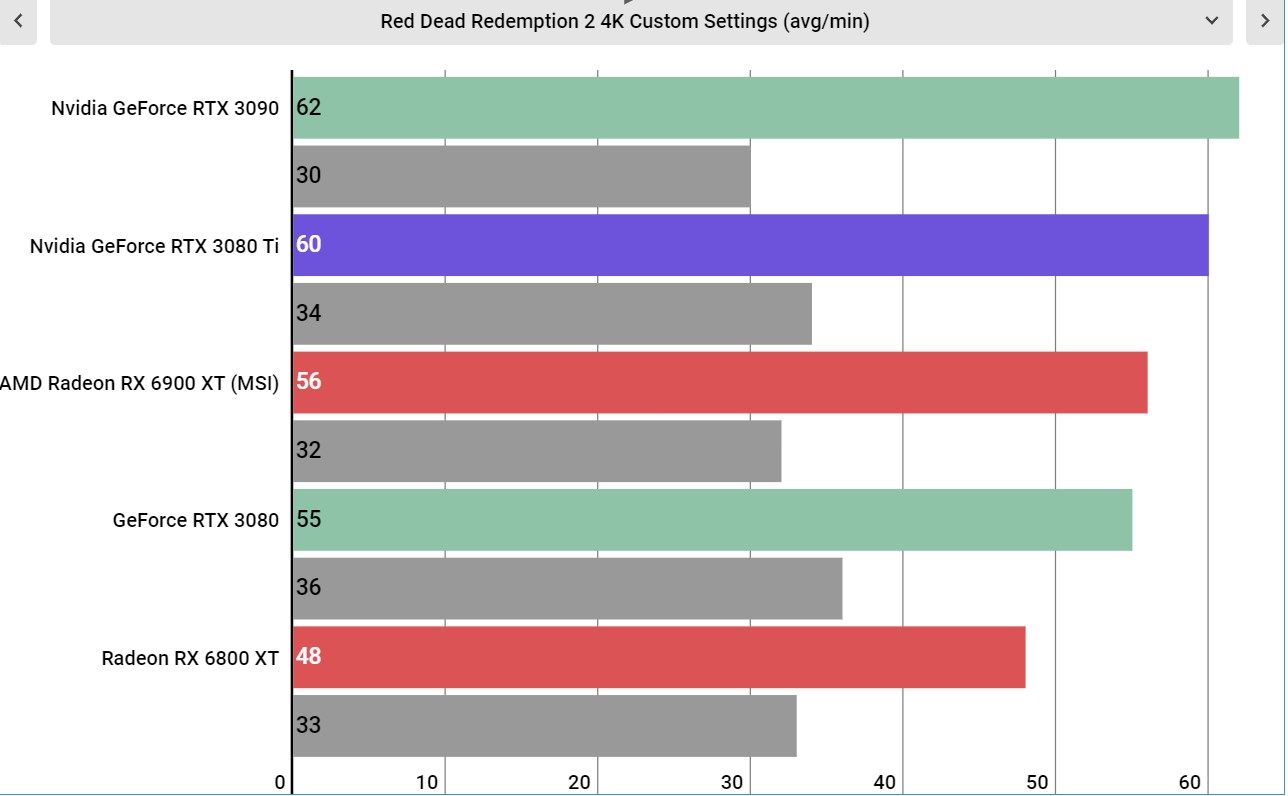
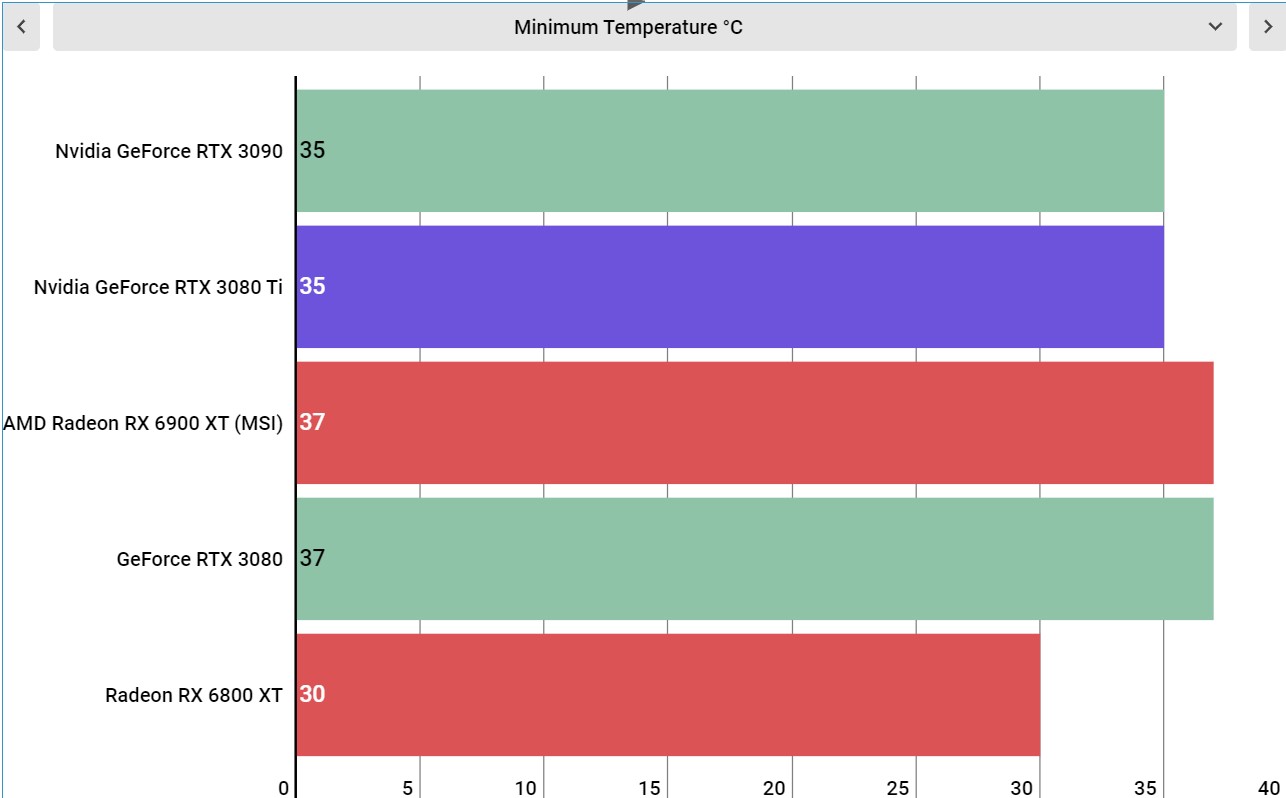
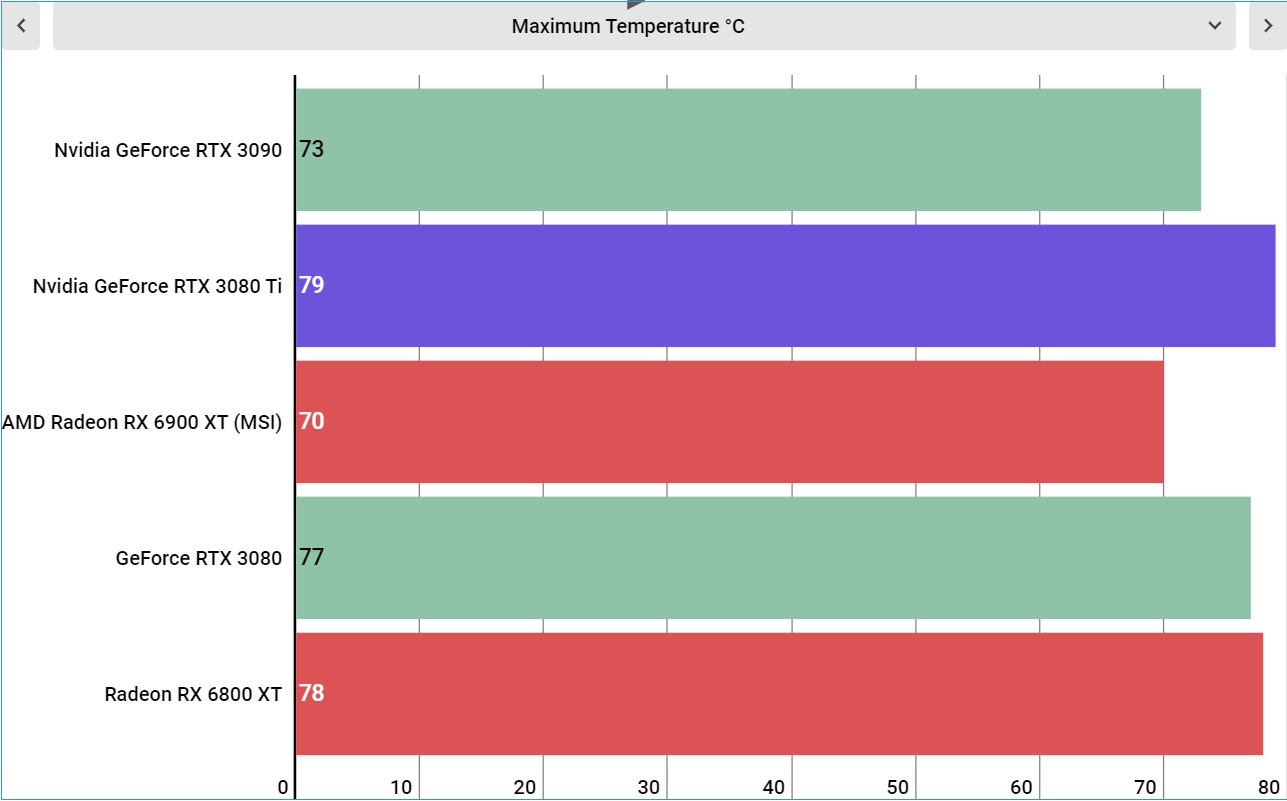
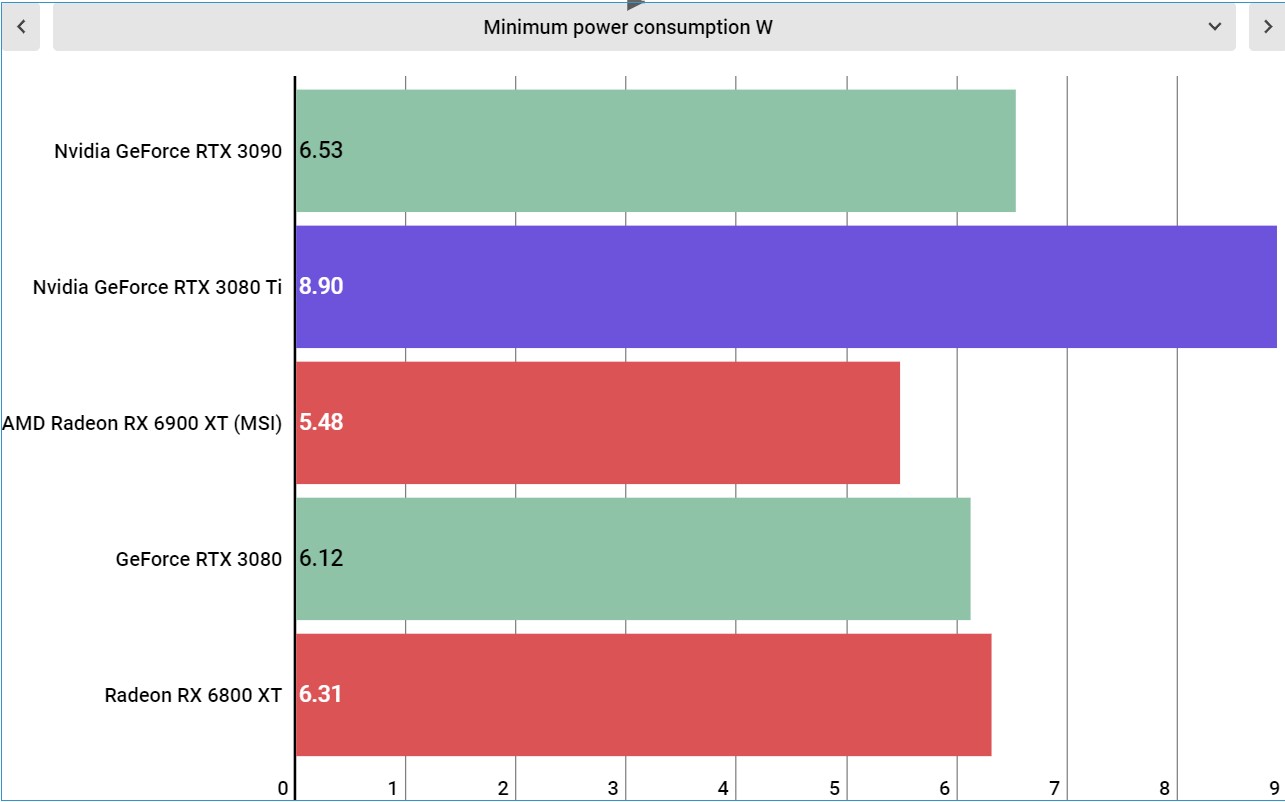
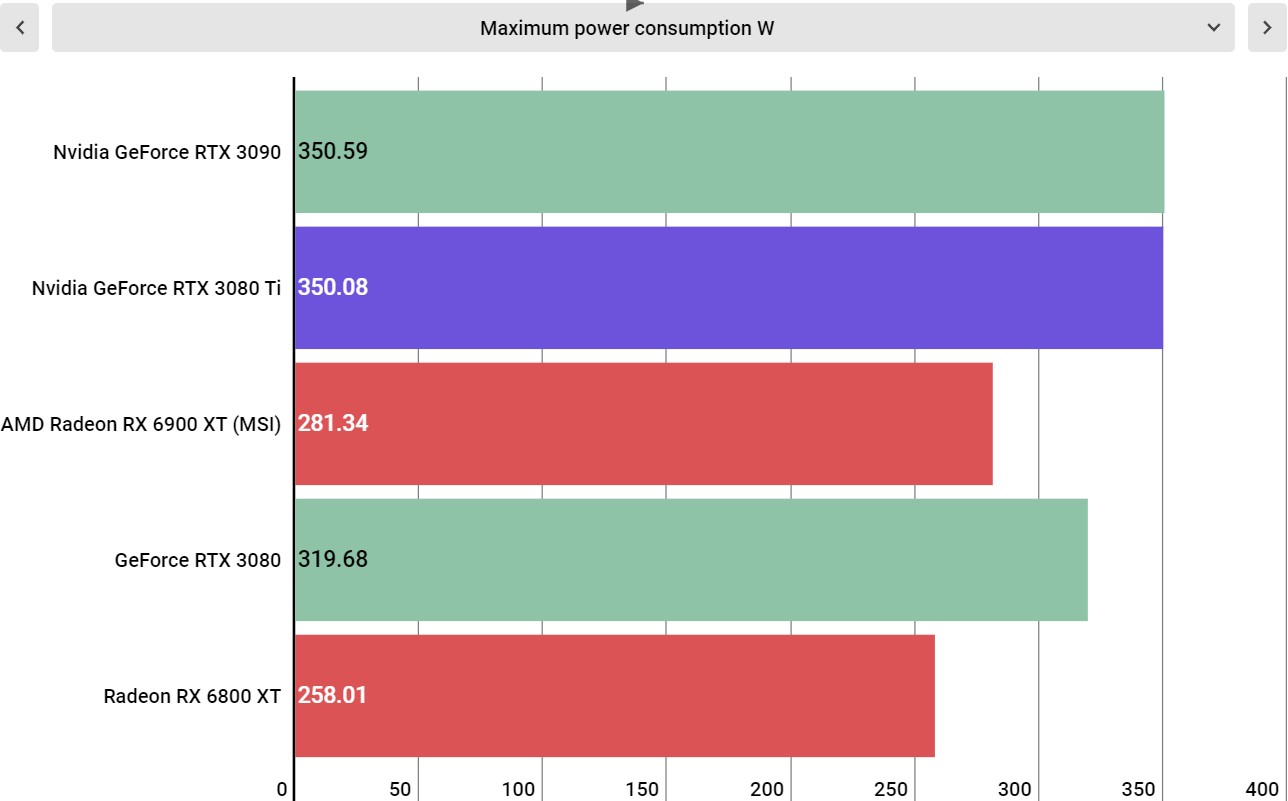
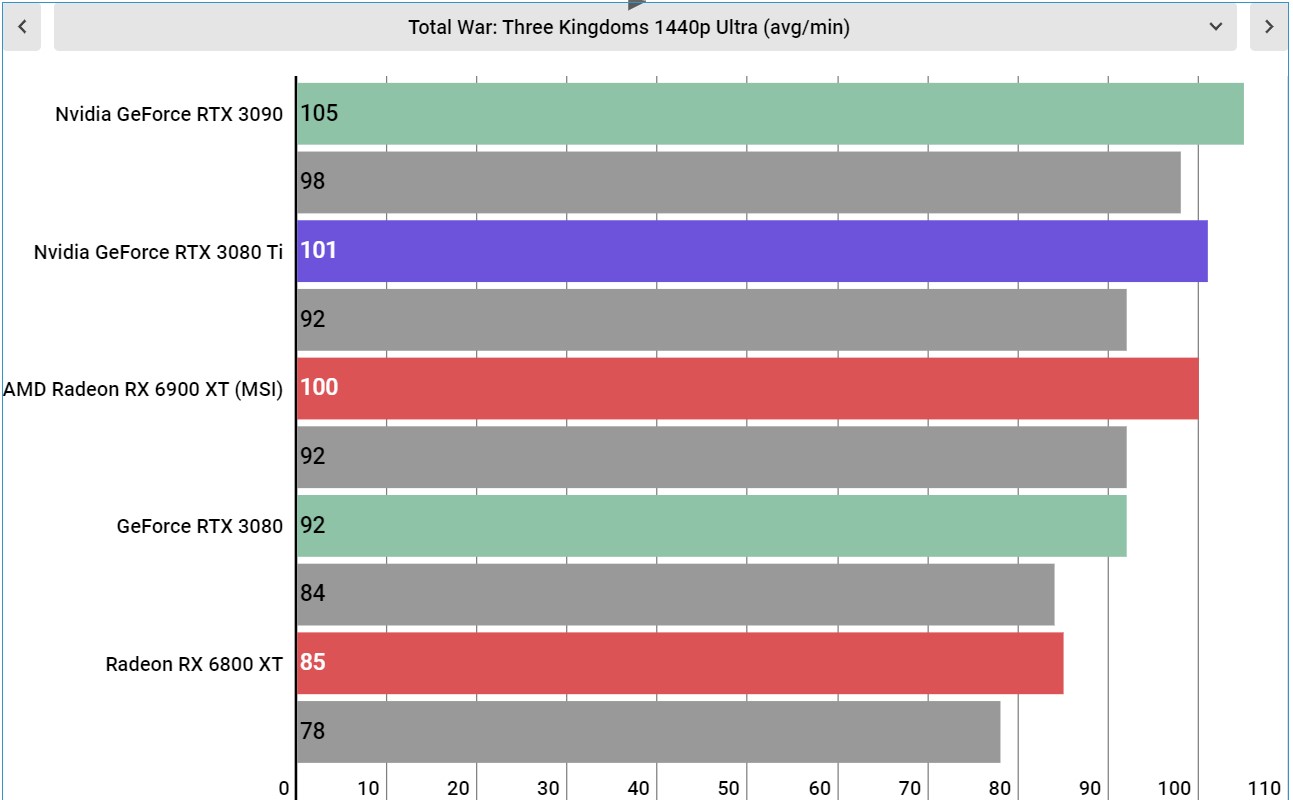
- Nvidia GeForce RTX 3090 levels of gaming performance
- Beats the AMD Radeon RX 6900 XT pretty handily
The Nvidia GeForce RTX 3080 Ti is basically as fast as the RTX 3090 in PC games, even despite the fact that it has half the VRAM. So, the RTX 3080 Ti is what you should buy if you want the best gaming performance you can get right now, and don’t really need to be running Blender or Resolve all the time.
This is the system we used to test the Nvidia GeForce RTX 3080 Ti Founders Edition:
CPU: Intel Core i9-11900K (8-core, up to 5.3GHz)
CPU Cooler: Cooler Master Masterliquid 360P Silver Edition
RAM: 64GB Corsair Dominator Platinum @ 3,200MHz
Motherboard: MSI MEG Z590 ACE
SSD: ADATA XPG SX8200 Pro @ 1TB
Power Supply: Phanteks RevoltX 1200
Case: Praxis Wetbench
And when we say that the performance is exactly the same, we’re not really exaggerating. Across our entire suite of benchmarks, the RTX 3080 Ti is usually within 1-2 fps of the RTX 3090.
The biggest difference between the two is in Dirt 5 at 1440p, where the RTX 3080 Ti gets 139 fps to the RTX 3090’s 146 fps. But if you’re playing Dirt 5, you’re probably not going to notice that 5% performance difference.
The Nvidia GeForce RTX 3080 Ti also beats the AMD Radeon RX 6900 XT in all but two tests: Fire Strike Ultra and Assassins Creed Valhalla.
But even then, at 4K the RTX 3080 Ti delivers the same performance as the RTX 3090, so you’re getting extremely good performance either way.
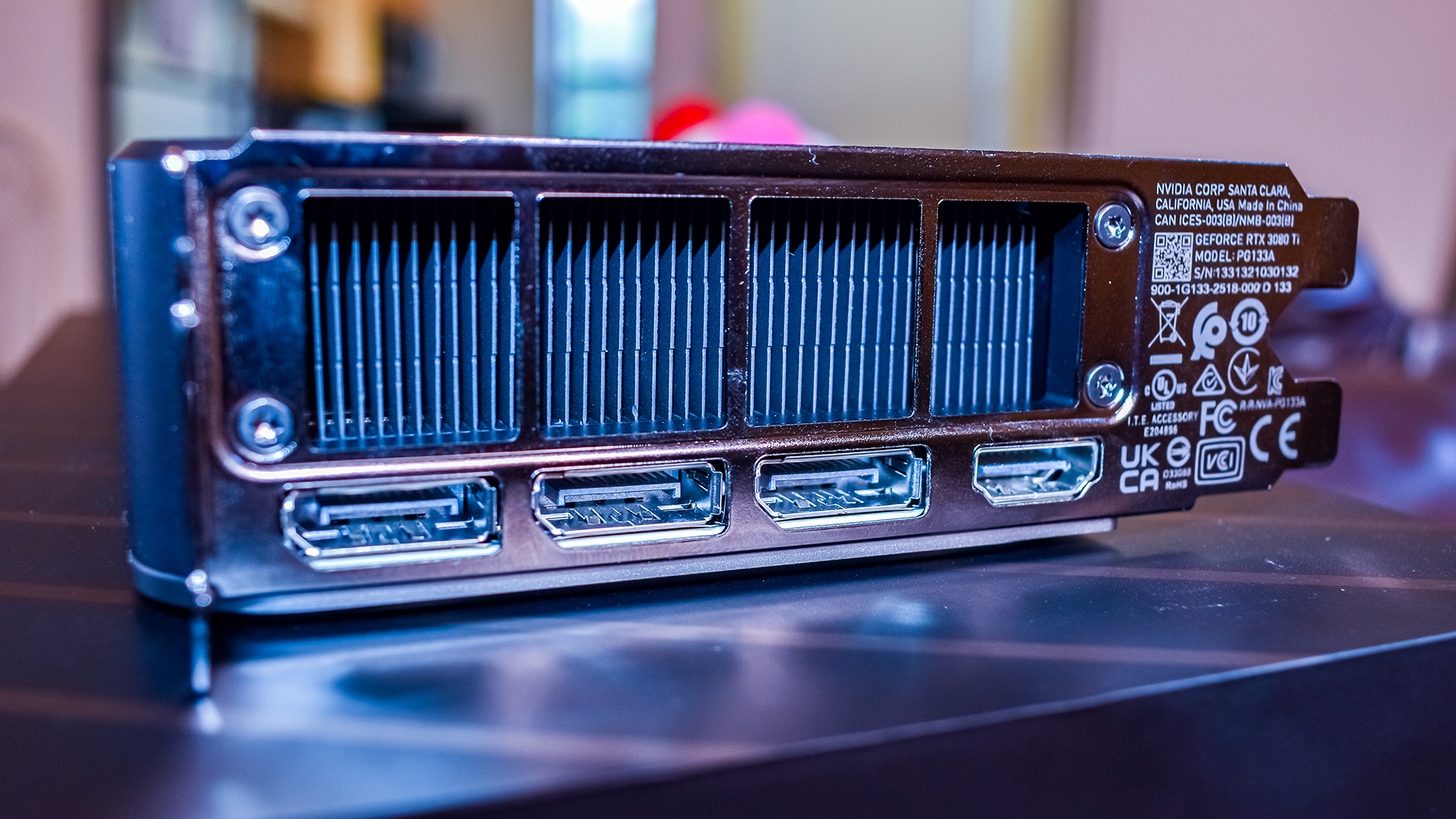
In the rest of the games though, the AMD Radeon RX 6900 XT is between 7-26% slower than the RTX 3080 Ti, so Assassins Creed Valhalla is definitely not the norm. This would usually be enough to make us flatly recommend the RTX 3080 Ti over the Radeon RX 6900 XT, but if we’re just going off of MSRP, Nvidia’s Graphics card is an extra $200. So, you’re going to want to make sure that the RTX 3080 Ti is worth that extra cost.
For pretty much any game that you’re looking to play, the Nvidia GeForce RTX 3080 Ti is going to be able to max it out at 4K, and that’s including all the fancy ray tracing effects you’ve probably been hearing about.
- Performance: 5 / 5
Should you buy an Nvidia GeForce RTX 3080 Ti?
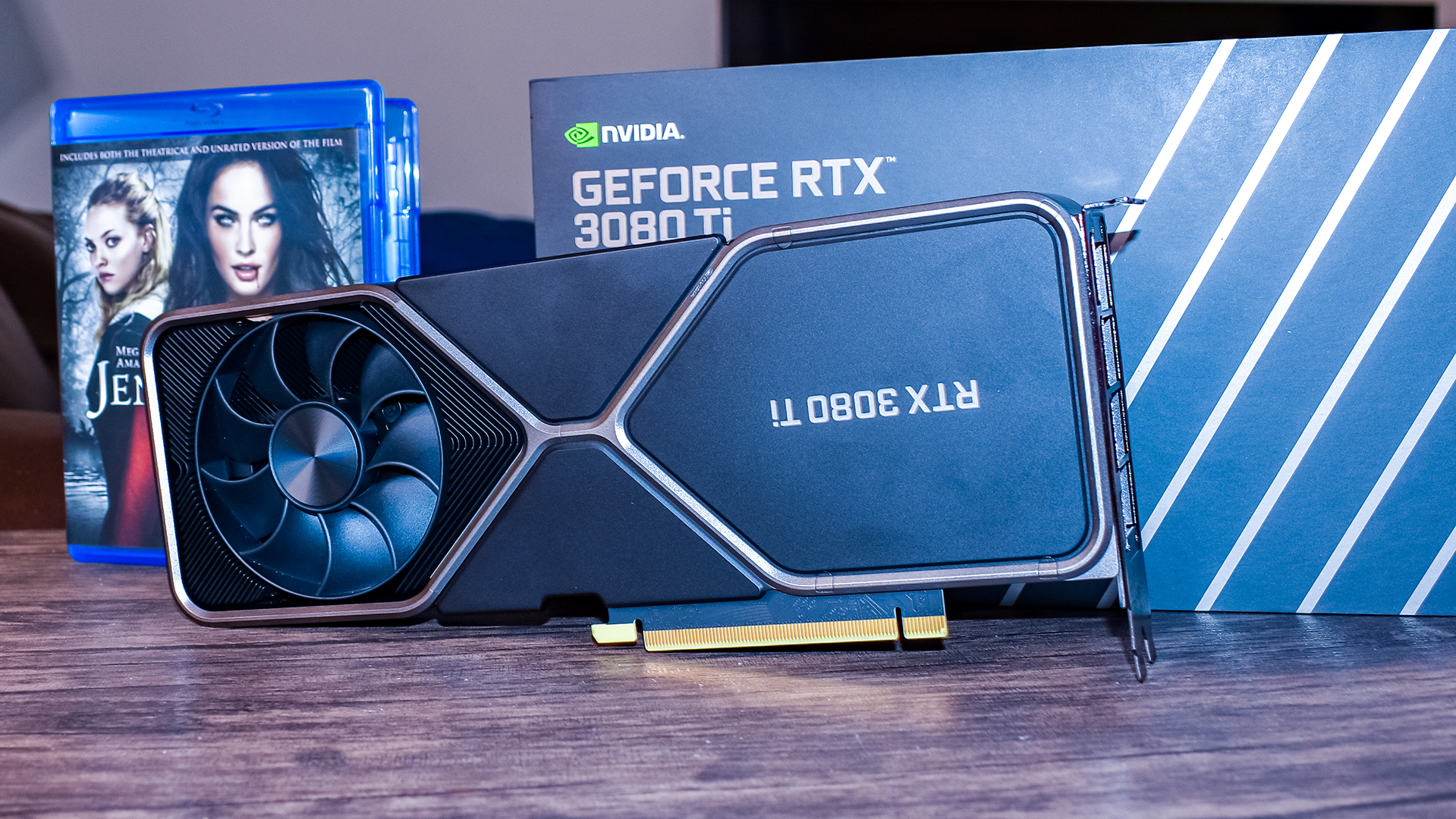
Buy it if…
You want no-compromises gaming performance
Because the RTX 3080 Ti basically brings the same level of performance as the RTX 3090 for a bit less money, this is the graphics card to get if you just want a top-notch gaming experience.
You have the budget for it
Even before accounting for aftermarket price increases, the Nvidia GeForce RTX 3080 Ti is an expensive graphics card. But, it is the best of the best, and we think it’s worth the price if you can afford it.
You want DLSS and ray tracing
Next to the Nvidia GeForce RTX 3090, the Nvidia GeForce RTX 3080 Ti is the best graphics card on the market right now if you care about ray tracing, and DLSS will help boost that performance even more.
Don’t buy it if...
You’re on a budget
Any graphics card in 2021 is expensive, but the Nvidia GeForce RTX 3080 Ti is one of the priciest ones out there.
You have a low-wattage power supply
The RTX 3080 Ti peaks at around 350W of power, so we recommend at least an 800W PSU. So, you might need an upgrade if you have a lesser power supply.
Also Consider
Nvidia GeForce RTX 3080
The RTX 3080 is not as powerful as its Ti variant, no doubt, but the performance gains are hard to square with the nearly doubling in price. If you're looking for the better value, the RTX 3080 is the clear winner here.
Read the full Nvidia GeForce RTX 3080 review
Nvidia GeForce RTX 3090
If you're going to spend this much money on a graphics card, you might ask whether it's worth just going all in and getting an RTX 3090. The value proposition isn't as good, but if you want the best of the best (within reason), then consider the RTX 3090, especially if you're running creative workloads and not just gaming.
Read the full Nvidia GeForce RTX 3090 review
AMD Radeon RX 6950 XT
In another universe, AMD would have lead the Big Navi launch with the RX 6950 XT. It is a compelling gaming graphics card, offering excellent 4K gaming performance and generally coming in at the same price as the RTX 3080 Ti.
Read the full AMD Radeon RX 6950 XT review
Nvidia GeForce RTX 3080 Ti: Report Card
| Value | While it's almost twice the price of the RTX 3080 with only a 17% bump in CUDA cores, this offers a compelling alternative to the RTX 3090 for those who balk at that card's nearly obscene pricetag. | 3.5 / 5 |
| Features & chipset | With a bump in CUDA core count and an additional 2GB VRAM over the RTX 3080, the RTX 3080 Ti brings a lot of hardware to the table | 5 / 5 |
| Design | The RTX 3080 Ti manages to get nearly an entire RTX 3090's worth of CUDA cores into the same sized package as the RTX 3080, which is impressive. | 4 / 5 |
| Performance | The RTX 3080 Ti is as good as the RTX 3090 in gaming performance and nearly as good at creative content workloads. | 5 / 5 |
| Total | If you're debating whether to get the RTX 3080 or its Ti variant, you really won't get a huge boost in performance over the RTX 3080 to justify the price, but as an alternative to the outrageously expensive RTX 3090, the RTX 3080 Ti deserves the title of Nvidia's new flagship graphics card. | 4.5 / 5 |
- First reviewed July 2021

Jackie Thomas is the Hardware and Buying Guides Editor at IGN. Previously, she was TechRadar's US computing editor. She is fat, queer and extremely online. Computers are the devil, but she just happens to be a satanist. If you need to know anything about computing components, PC gaming or the best laptop on the market, don't be afraid to drop her a line on Twitter or through email.
